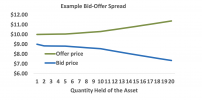DenisAmbrosov
New Member
I am not sure about the offer price... When the financial institution tries to liquidate the large position [n] let's say n > 10, the spread widens. I understand why the bid price widens, as there is a surplus, a lot of supply in the market. But I can't get why the offer price widens.

